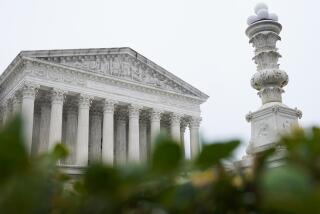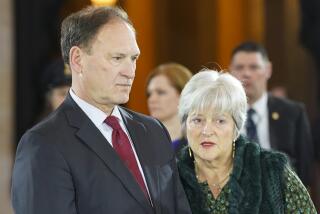Supreme Court upholds use of affirmative action at universities
Reporting from Washington — The 30-year conservative campaign to strike down race-based affirmative action came to an apparent end Thursday when a University of Texas admissions policy was upheld by Justice Anthony M. Kennedy, the last of the Reagan appointees to the Supreme Court and often the deciding vote on divisive issues.
Kennedy said a university and its leaders deserve “considerable deference” as they seek “student body diversity” that is “central to its identity and educational mission.”
By a 4-3 vote, the justices rejected a discrimination claim brought by a white student who had good but not excellent credentials when she was turned down for admission by the Austin campus in 2008. Abigail Fisher became the plaintiff in a suit that asked the court to rule that weighing a student’s race or ethnicity violated the Constitution’s guarantee of equal protection of the laws.
The court’s decision is a major victory for affirmative action and something of a surprise because Kennedy had been a steady critic of race-based admissions policies in the past.
Kennedy joined the high court in the 1980s shortly after Justice Antonin Scalia, and both expressed the view that it was unconstitutional to give some students an edge over others because of their race. But conservatives repeatedly fell just short of mustering a majority to strike down such policies.
When the court tackled the issue in 2003, Justice Sandra Day O’Connor spoke for a 5-4 majority to uphold a University of Michigan policy that allowed for considering a student’s race as one of many factors in evaluating applicants. Kennedy and Scalia dissented.
More recently, with O’Connor having been replaced by the more conservative Justice Samuel A. Alito Jr., conservatives saw the Texas case as an opportunity for the court to finally reject such policies.
But Scalia died suddenly in February, shortly after arguments were heard. And rather than joining his fellow conservatives to rein in the Texas plan because it relied in part on race, Kennedy joined the liberals to uphold it, albeit with limitations.
He said university officials make an “academic judgment” about the students who will contribute to the campus, and judges should generally defer to their decisions. He also said a close look at the evidence showed “race consciousness played a role in only a small portion of admissions decisions” at the University of Texas in 2008, the year Fisher was rejected by the university.
This, Kennedy said, is a sign the policy was “narrowly tailored” to open the door for a small number of talented minority students and not a rigid rule that put a heavy stress on race.
Scholars and lawyers who closely follow these cases called Kennedy’s shift a major one.
“This is momentous,” said Kimberly West-Faulcon, a law professor at the Loyola Law School in Los Angeles. “Justice Kennedy has finally found a racial affirmative action policy that he was willing to endorse. This is a significant departure.”
In the era of Black Lives Matter, she said, Kennedy is showing a new willingness to protect racial rights similar to the way he has protected rights for gays and lesbians.
“This is quite a shocker,” said Richard Kahlenberg, a scholar at the Century Foundation in Washington and a critic of race-based policy.
In past decisions, Kennedy had encouraged universities to rely on race-neutral policies to increase minority admissions. Texas was widely praised for implementing the “top 10% law,” which guaranteed admission to students in the top 10% of their high school. That dramatically increased the number of minority admissions without using affirmative action.
But officials at the Austin campus said they still needed an affirmative action plan to enroll minority students who fell short of the 10% cutoff at the state’s best and mostly white schools. They said a limited use of affirmative action could be used to admit several dozen minority students each year who would probably do well at the Austin campus.
That triggered a lawsuit by Edward Blum, a retired stock broker and University of Texas graduate, who said the university had no legal basis for evaluating applicants based on their race. He enlisted Fisher as a plaintiff.
Thursday’s ruling should give comfort to college officials across the nation who consider a student’s race or ethnicity in admissions. A broad ruling by the high court rejecting affirmative action could have forced those institutions to revise such policies.
But the court’s upholding of the University of Texas plan is not likely to have an immediate impact in states such as California, Michigan or Florida that have abolished race-based admissions plans though ballot measures or state laws.
Faith Carter, a senior at the University of Texas at Austin, said the high court’s ruling was a relief to her and other minority students.
“It makes me proud. It makes me feel there is an effort to support diversity in the university,” said Carter, 21, of Houston, who is Texas zone chair of the National Society of Black Engineers.
She noted that recent figures show the college student body is 4% African American, lower than at other large schools.
“Just sending the message that this is lawful, that the Supreme Court did find this lawful, that alone helps,” she said.
The issue of affirmative action has closely split the justices for decades, going back to the Bakke decision of 1978. Then, the court in an unusual 5-4 split, struck down a University of California affirmative action policy but said that colleges may consider a student’s race as a “plus factor.”
The 2003 decision in the Michigan case repeated that view. But after O’Connor retired and was replaced by Alito, university officials worried that the high court was poised to strike down affirmative action entirely.
Joining Kennedy’s 20-page opinion in full were liberal Justices Ruth Bader Ginsburg, Stephen G. Breyer and Sonia Sotomayor. Justice Elena Kagan recused herself from the case because she had filed an earlier brief in support of the university when she was the U.S. solicitor general.
Alito wrote a 51-page dissent and read much of it in the court. “Something strange has happened since our prior decision in this case,” he said. He was referring to the court’s action on the same case three years ago, when a skeptical majority, led by Kennedy, sent the matter back to a lower court for closer review.
Alito, joined in Thursday’s dissent by Chief Justice John G. Roberts Jr. and Justice Clarence Thomas, said the university had failed to “justify systematic racial discrimination” in its admissions policy.
He faulted Kennedy for deferring to university officials, particularly after Kennedy had suggested in the earlier decision that the court would demand stricter proof of the need for such a program.
Alito also questioned why the Austin campus was seeking more privileged minority students from top high schools. “This argument turns affirmative action on its head,” he said. “Affirmative action programs were created to help disadvantaged students.”
Speaking in the court, Alito said it was not clear whether this was a “one-off” decision that will have no lasting impact or the beginning of a significant shift in favor of affirmative action. That will only become clear, he said, when the next case comes along.
Times staff writer Molly Hennessy-Fiske in Houston contributed to this report.
On Twitter: @DavidGSavage
ALSO
Supreme Court deadlocks on Obama immigration plan
Freddie Gray case: Judge to issue verdict in Officer Caesar Goodson trial
House Democrats continue to protest as Senate considers vote on gun legislation
UPDATES:
2:29 p.m.: This story was updated with more background and analysis.
9:28 a.m.: This story was updated with additional reaction and analysis.
This story was originally published at 7:20 a.m.
More to Read
Sign up for Essential California
The most important California stories and recommendations in your inbox every morning.
You may occasionally receive promotional content from the Los Angeles Times.











